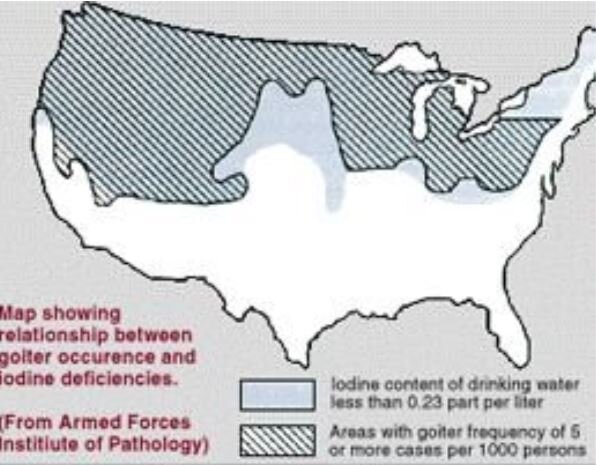A 67 y.o. male comes in with shortness of breath
his cxr is shown
Our patient had a large substernal goiter compressing the bronchi.
Early Chinese medical writings in 3600 BC were the first to record a decrease in goiter size with ingestion of burnt sea sponge. The discovery of iodine was an accidental discovery during the making of gunpowder in 1811. Courtois, a French chemist, observed a purple smoke arising for seaweed ash treated with sulphuric acid. It was eventually purified from this reaction and named iodine after the Greek word “ioeides” or violet colored.
Goiters were most prevalent in the upper Midwest and west until the 1920’s when salt became iodized. When salt was originally iodized, an outbreak of thyrotoxicosis occurred and many states did not adopt iodized salt until the 1950’s. In patients with underlying goiters even ICU exposure to betadiene or IV contrast can trigger thyrotoxicosis . Currently only 70-76% of households use iodized salt. Certain segments of the population notably pregnant women and women of child bearing age are at risk for iodine deficiency.
THE MESSAGE IS: Iodine administration can result in hyperthyroidism in patients with goiters and hypothyroidism in autoimmune thyroiditis.
Our patient had R phrenic nerve paralysis which made him inoperable. He worsened in the ED and developed hypercarbic respiratory failure. Multiple attempts to intubate in the ED were unsuccessful including a failed cricoid trach. The pt was placed on ecmo and a #7 Shiley XLT was eventually placed. He was decannulated but remains vent dependent with ongoing pneumonia.
Leung A, Braverman L, Pearce E. History of US Iodine fortification and supplementation. 2012 Nutrients Nov;4(11):1740-1746.
Caldwell K, Makhmudov A, Ely E, et al. Iodine status of the US Population National Health and Nutrition Examination Survery 2005-6 and 2007-8. Thyroid. 2011;21:419-427.
Delange F, Benoist B, Alnwick D. Risks of iodine-induced hyperthyroidism after correction of iodine deficiency by iodized salt. 1999. Thyroid . liebertpub.com doi.org/10.1089/thy.1999.9.545
Brotfain E, Koyfman L et al. Iodine-induced hyperthyroidism—an old clinical entity that is still relevant to daily ICU practice: A case report. Case Reports in Endocrinology 2013. Vol 2013, article ID 792745.
goiter on ct


